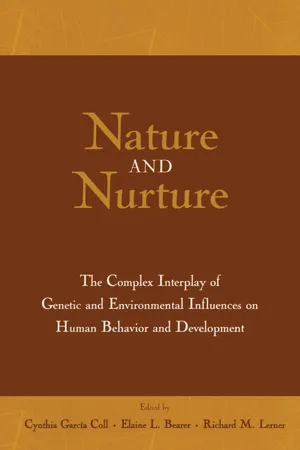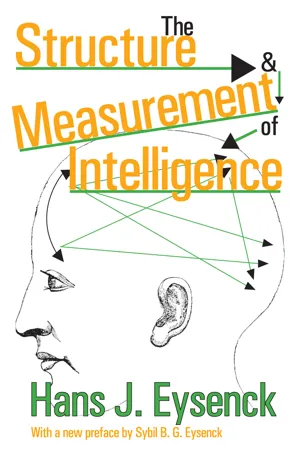Psychology
Nature-Nurture Methods
Nature-nurture methods refer to the study of how genetic and environmental factors interact to influence human behavior and development. Researchers use various methods, such as twin studies, adoption studies, and gene-environment interaction studies, to investigate the relative contributions of nature and nurture to psychological traits and disorders. These methods help to understand the complex interplay between genetics and the environment in shaping human characteristics.
Written by Perlego with AI-assistance
Related key terms
8 Key excerpts on "Nature-Nurture Methods"
- eBook - ePub
Nature and Nurture
The Complex Interplay of Genetic and Environmental Influences on Human Behavior and Development
- Cynthia Garcia Coll, Elaine L. Bearer, Richard M. Lerner, Cynthia Garcia Coll, Elaine L. Bearer, Richard M. Lerner(Authors)
- 2014(Publication Date)
- Psychology Press(Publisher)
Few areas of inquiry have captivated the entire realm of social sciences like the nature versus nurture debate. Investigating the impact of genetic and environmental influences on human development, and the processes involved in mediating these influences, poses perhaps the most fundamental question we can ask about human nature. The nature–nurture question continues to gamer attention, and with the swift progress of the Human Genome Project, interest in this issue will only grow.Historically, the intellectual battleground between hereditarians and environmentalists spanned a variety of academic disciplines, including psychology, sociology, and anthropology, along with professional realms such as education and medicine. The primary debate, in the eyes of the public, was whether nature or nurture was responsible for a given outcome. In later years, the focus shifted from contention to cooperation; rather than asking whether genetic or environmental factors determine a given outcome, researchers recognized the importance of both (Plomin, 1996). Although still often misunderstood by the public, the realization that both heredity and environment play a role in practically all human behavior superseded myopic notions such as genetic determinism or strict environmentalism. Thus, through methods such as twin and adoption studies, behavioral geneticists began to study the relative impact of heredity and environment on human behavior (see Plomin, DeFries, McClearn, & McGuffin, 2001).Social scientists have also recognized, however, that the calculation of heritabilities for traits and the partitioning of variance into genetic and environmental components—the traditional domain of behavioral genetics—is of limited value (Bronfenbrenner & Ceci, 1994; Turkheimer, 1998). While it may be useful to know, the determination of how much variance is accounted for by genetic and environmental factors does not reveal how the two interact to yield developmental outcomes. The ultimate nature–nurture question, as originally posed by Anastasi (1958) and restated by Bronfenbrenner and Ceci (1993), is not, “How much?”— but rather, “How?” - eBook - ePub
AQA Psychology A Level Paper Three: Issues and Debates
Issues and Debates
- Phil Gorman(Author)
- 2020(Publication Date)
- Routledge(Publisher)
Chapter 5 The nature-nurture debateSpec check
The nature–nurture debate: the relative importance of heredity and environment in determining behaviour; the interactionist approach.AO1 (Knowledge and understanding): What is the nature-nurture debate?
The nature–nurture debate is one of the oldest debates in psychology. It is something that is commented on by many people on a regular basis, often without realising and certainly without actually referring to the terms nature or nurture themselves. In fact, the terms nature and nurture didn’t come into common use until the sixteenth century, but the issue has been hotly debated for hundreds, if not thousands, of years. More recently, Francis Galton coined the term ‘nature versus nurture’ in the nineteenth century to refer to the debate between those who believe that our genetic inheritance is most important in determining our behaviour and those who believe that all the influences that occur after our birth (or conception) are most important.Question time
When was the last time you talked about some form of behaviour being either due to external influences (e.g. parents) or due to internal influences (e.g. temperament)? What about that crying baby on the bus/train/plane or in the supermarket or cinema? Didn’t you wonder about the kind of parents that might have produced such a ‘brat’? Or whether it might just be a difficult child?What do we mean by nature?
Bynaturewe mean all those internal influences that lead to behaviour being predetermined orpre-programmedinto us before the environment has had a chance to have an effect. They are sometimes referred to asinnate characteristicsbecause they are features of our personality that are with us from birth and are therefore part of our biological make-up rather than anything learned in response to our situation. Such features are believed to begeneticas they are as much a part of our DNA as our physical characteristics are, such as eye colour or the size of our feet. Therefore, the belief would be that these features areinherited - eBook - ePub
- Richard M. Lerner(Author)
- 2018(Publication Date)
- Routledge(Publisher)
This issue pertains to the source of human behavior and development. Simply, a question is raised about where behavior and development come from. In its most extreme form the issue pertains to whether behavior and development derive from nature (or in modern terms, heredity, maturation, or genes) or, at the other extreme, whether behavior and development derive from nurture (or in more modern terms, environment, experience, or learning). However, whatever terms are used, the issue raises questions about how inborn, intrinsic, native, or in short, nature characteristics (for example, genes) may contribute to development and/or, in turn, how acquired, socialized, environmental, experienced, or in short, nurture characteristics (for example, stimulus–response connections, education, or socialization) may play a role in development. Table 3.1 lists some terms used in regard to nature and nurture contributions, respectively. The separation, or split, between nature and nurture illustrated in the table reflects a key distinction made by philosophers and scientists about the bases of human development. The separation between nature and nurture is an exemplar of the tendency in modern thought about human development to approach the study of people with concepts that reflect conceptual “splits.” That is, realities about development are discussed or debated in either-or terms. I noted in Chapters 1 and 2 that such bifurcation of concepts of development can be traced in modern philosophy at least to the ideas of the seventeenth-century philosopher, René Descartes. The study of human development has been a field wherein fundamental conceptual issues have been framed traditionally as Cartesian splits (Overton, 2015a) - eBook - ePub
- Brad Piekkola(Author)
- 2016(Publication Date)
- SAGE Publications Ltd(Publisher)
5 Nature and NurtureLearning Objective
This chapter has as its concern a debate that begins with Charles Darwin’s cousin Francis Galton (1822–1911) around the degree to which human psychological functions, especially intelligence, is a matter of biological inheritance or whether experience makes any contribution. It is known as the argument over nature versus nurture. More specifically we will consider:- Galton’s dismissal of nurture in favor of eugenics and biological determinism.
- Intelligence testing and the elimination of human defect.
- Evolutionary psychology and the explanation of human activity as adaptations to ancient environmental challenges encoded in brain mechanisms.
- Cultural psychology’s explanations of human conduct in terms of historical, cultural developments and processes.
Framing Questions
- Do you believe that some people are naturally superior/inferior to other people and that there is nothing to do to alter innate biological influences?
- Can the mental behavior of modern humans be explained in terms of basic cognitive mechanisms of the brain that solved problems in the evolutionary past?
- If we can understand the differences between groups of people in terms of cultural influences might there be a basis for recognizing our common humanity in that?
Introduction
The terms nature and nurture were introduced by Richard Mulcaster (1531–1611), an educator, in reference to what he believed were the two influences that acted together in promoting the development of the child (West and King, 1987). Parental inheritance and experience thus worked together in establishing the capabilities of the adult. Galton, as will be explained, tended to treat these terms, and what they represent, as opposed. He favored an hereditarian - eBook - ePub
Human Behavior and Social Environments
A Biopsychosocial Approach
- Dennis Saleebey(Author)
- 2001(Publication Date)
- Columbia University Press(Publisher)
Although it is clear to all that nature and nurture both play a role, most of what we read touts the importance of nurture (usually narrowly meaning the parents’ effect on their children). We are less certain about the role of each, how genetic factors vary within different environments, and how different environments vary in their impact on children’s personalities and adult fates. The socialization researchers and theorists are much more likely to attend to the supposed correlation between parental behaviors and traits and childhood and, later, the adult personalities and pathologies, strengths, and failings of their children. Behavioral geneticists, on the other hand, are more wary about the role of the parents but absorbed by the role of heredity and how it interacts with and even influences the available interpersonal environment (Plomin, 1990). Does a child born with what turns out to look like a “shy temperament” increase the likelihood that parents will be more active and insistent that the child participates in social events? Or would they be more likely to be protective and doting? Or is there no way to predict what might happen because of the multiple interacting influences, including siblings, peers, culture, social institutions, and the child’s own response to parental behaviors? Or does it make little difference—the shy child becomes the retiring adult no matter what? Obviously, there is much perplexity on everybody’s part, including my own, about how nature and nurture interact. So my effort here will be to sort out, as best I can, some of the thinking about and research findings regarding the relative influence of nature and nurture. But the most difficult task will be defining the “and”—what the interplay between nature and nurture looks like - eBook - ePub
- Hans Eysenck(Author)
- 2019(Publication Date)
- Routledge(Publisher)
Of course, such extreme views are quite unfounded in reality, and where they have subsequently been allowed to influence social policy they have been disastrous. Extreme hereditarian views have been used, frequently, to support eugenic arguments both cruel and absurd and to justify the persecution and oppression of minorities. These evils are now, thankfully, less evident, although the world is far from free of them. Less obvious, but hardly less dangerous, is extreme environmentalism which is increasingly used to justify a Procrustean and intolerant treatment of human individuality in the name of equality.Fortunately, these extreme views have seldom been characteristic of those actively carrying out research into these problems, and we now have a wealth of evidence demonstrating the combined importance of both nature and nurture in determining individual differences in behaviour. Hopefully this knowledge has an important contribution to make to human welfare. It is this evidence in relation to IQ and educational achievement with which we will be concerned in the next three chapters. In the present one we will be concerned mainly with nature, attempting to assess the extent of genetic influences relative to those stemming from the environment and looking, in some detail, at the forms these genetic influences take. In the next chapter we will be concerned more with nurture examining factors such as early environment, the economic quality of the home, its cultural atmosphere and interactions with parents and other children. Finally, in Chapter 7 , we will be concerned with how nature and nurture interact during an individual's lifetime and the role they play in influencing social structure.The theoretical model underlying the partitioning of human variation recognizes that the phenotype or the individuals's level for the trait in question will be determined both by his genetic makeup and his environmental circumstances. In its basic form, the phenotype (P) is expressed quite simply as the sum of the genetic effect (G) and the environmental effect (E). - eBook - ePub
Environmental Psychology
Behaviour and Experience In Context
- Tony Cassidy(Author)
- 2013(Publication Date)
- Psychology Press(Publisher)
Chapter Two Theory and method in environmental psychologyEnvironmental psychology is interdisciplinary in nature, therefore perhaps even more than some other fields of applied psychology it relies on a diverse range of theory. In any area of applied psychology there is no single or unified theory. Rather, applied psychologists have access to the total range of theoretical perspectives in psychology. Indeed this is as it should be because it allows greater scope and flexibility in application and there is little reason to expect that the complex subject matter of psychology, human experience and behaviour, should lend itself to a simple or single theoretical explanation.In terms of the basic perspectives in psychology, environmental psychology adopts an interactional framework both in terms of person-situation interaction and nature-nurture interaction. Explanations incorporate all the psychological perspectives and, since environmental psychology is an applied area, it is not a matter of any one theory being the correct one, rather it is a case of which one provides the most useful explanation and enhances a practical intervention.While no unifying theory exists, some themes can be identified which reflect a number of different ways of conceptualising the person-environment transaction. Veitch and Arkkelin (1995) identify four major historical trends and six current theoretical themes. The historical trends are geographical determinism, ecological biology, behaviourism and Gestalt psychology (p. 17).Geographical determinismThe basic premise of geographical determinism is that the geographical environment directly influences behaviour and experience in that it provides challenge. Extremely low levels of challenge fail to provide the stimulation necessary to motivate. Extremely high levels of challenge are damaging. This effect is akin to the arousal level theories to be discussed later, and reflects the Yerkes-Dodson law (see Fig. 6 - eBook - ePub
- M. Posthumus, M. Collins(Authors)
- 2016(Publication Date)
- S. Karger(Publisher)
nurture in determining human athletic ability. On the nature (genetics) side, a review is provided with emphasis on the historical research and on several areas which are likely to be important for future research, including next-generation sequencing technologies. In addition, a number of well-designed training studies that could possibly reveal the biological mechanism (‘cause’) behind the association between gene variants and athletic ability are discussed. On the nurture (environment) side, we discuss common environmental variables including deliberate practice, family support, and the birthplace effect, which may be important in becoming an elite athlete. Developmental effects are difficult to disassociate with genetic effects, because the early life environment may have long-lasting effects in adulthood. With this in mind, the fetal programming hypothesis is also briefly reviewed, as fetal programming provides an excellent example of how the environment interacts with genetics. We conclude that the traditional argument of nature versus nurture is no longer relevant, as it has been clearly established that both are important factors in the road to becoming an elite athlete. With the availability of the next-generation genetics (sequencing) techniques, it is hoped that future studies will reveal the relevant genes influencing performance, as well as the interaction between those genes and environmental (nurture) factors.© 2016 S. Karger AG, BaselNature versus Nurture or Nature Plus Nurture in Sports?
Human athletic ability is influenced by a number of factors, such as environmental, physiological, psychological, and sociocultural variables, and many others [1 ]. The term ‘nature versus nurture’, initiated many years ago, refers to whether heredity (nature) or the environment (nurture) has a greater impact on human development (behaviour, habits, intelligence, aggressive tendencies, athletic performance, etc.). Possessing exceptional ability/abilities is, at least partially, attributed to one's genes. Talent is passed down from parents or grandparents to the next generation, and this can include intelligence or athletic performance. In fact, many athletes from the past and today are members of the same family.However, there is also evidence that talent is learned and earned through extended and intense practice of a skill, namely ‘No pain, no gain’. This idea is encapsulated in a golden rule made popular by the writer Malcolm Gladwell in his book [2 ]. This ‘10,000 h of practice’ rule [3 ] is based on research by psychologist Anders Ericsson at Florida State University. The rule suggests that about 10,000 h of dedicated practice in your particular field is sufficient to bring out the best in you. In essence, Ericsson's theory suggests that sufficient practice in a particular skill can take anyone to a proficiency level equivalent to that of a top classical musician [3
Learn about this page
Index pages curate the most relevant extracts from our library of academic textbooks. They’ve been created using an in-house natural language model (NLM), each adding context and meaning to key research topics.







